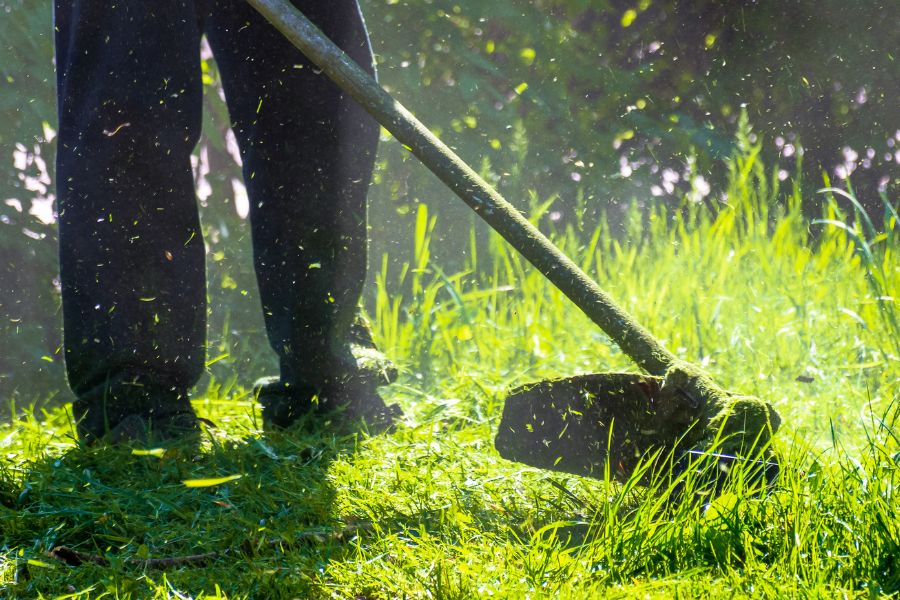The concept of aesthetic grass plays an integral part in modern landscaping. Stipped grasses or well-maintained lawns blend beauty, functionality, and environmental consciousness. Grass, in its various forms, including natural and artificial turf, contributes significantly to the overall aesthetics of outdoor spaces. From the lush green carpets of lawns to the low maintenance convenience of artificial grass, the choices are diverse and impactful. Each type, tall fescue or fine fescue, brings its unique shade, texture, and resilience, offering a palette for gardeners and landscape architects. Whether you live in a townhouse or a deluxe house, a lawn will spruce up your outdoor space. We’ll delve into aesthetic grass, its types, and the art of maintaining its beauty and health. Let’s find out how to make your garden stand out in your neighborhood.
Types of Aesthetic Grass
Kentucky Bluegrass
Known for its soft, picture-perfect lawn appeal, Kentucky Bluegrass is a popular choice in many parts of the country. It demands attention with its plush texture. But it requires a fair amount of maintenance, including regular mowing and watering.
Tall Fescue
A robust and resilient variety, tall fescue stands up to foot traffic and play, making it an ideal choice for families with children. Its low-maintenance nature and tolerance to drought make it a practical option for lawns in various climates.
Fine Fescue
This type of grass thrives in particular shade conditions and lower pH soils. It’s known for its delicate texture and is a good fit for areas with less foot traffic. Fine fescue requires plenty of care and attention to maintain its aesthetic appeal.
Artificial Grass/Turf
Offering a year-round green appearance with minimal maintenance, artificial grass has become a staple in modern landscaping. It’s an energy-efficient and water-conserving option. This is perfect for those looking to reduce their environmental impact while maintaining a green landscape.
Ornamental Grasses
Ornamental grasses add texture, movement, and color to gardens and landscapes. They are a testament to the diversity of grass as a plant:
- Prairie Dropseed: Its soft mounds and late-summer flowers are a graceful contributor to garden aesthetics.
- Switchgrass: This grass adds structure with its upright growth and is hardy in various conditions.
- Japanese Forest Grass: Known for its cascading habit and variegated leaves, it provides a lush, green ground cover in shaded areas.
Cultivation and Care
Cultivating and maintaining aesthetic grass requires combining horticulture knowledge and practical landscaping skills. Essential aspects include:
- Sunlight and Shade: Grasses have varying needs for sunlight. While some thrive in full sun, others require partial shade to reach their full potential.
- Watering and Fertilizing: Regular watering is crucial, especially for natural grasses. Fertilizing helps in maintaining the lush green color and promotes healthy growth.
- Soil Quality: Good soil is the foundation of a healthy lawn or garden. It should be well-drained yet retain enough moisture to support the grass.
- Mowing and Trimming: Regular mowing helps maintain the desired height and contributes to the density and health of the grass.
Landscape Design with Aesthetic Grass
Landscape design with aesthetic grass transforms ordinary yards into picturesque scenes, blending beauty and functionality. The key lies in choosing the right type of grass and arranging it thoughtfully to enhance the overall aesthetics of the landscape.
- Choosing the Right Grass: The grass selection should align with the area’s climatic conditions, soil type, and intended use. For instance, drought-resistant varieties like Bermuda or Zoysia are ideal for sunny, dry areas. On the flip side, fine fescue is better for cooler, shaded regions.
- Designing with Texture and Color: Different types of grass offer varied textures and shades of green. Combining these can create a visually appealing tapestry in the yard. For example, Kentucky bluegrass’s soft, fine blades contrast beautifully with the more robust texture of tall fescue.
- Functional Aesthetics: Grass areas can be designed for specific purposes, like a soft play area for children or a serene green space for relaxation. The design should consider practical aspects like foot traffic, maintenance needs, and space utilization.
- Integrating with Other Landscape Elements: Grass should harmonize with other elements in the garden, such as flower beds, shrubs, or hardscapes. This integration creates a cohesive and inviting outdoor space.
- Visual Impact: The strategic grass placement guides the eye and creates focal points in the landscape. For example, a well-maintained lawn can be a stunning backdrop for a flower garden or a sculptural element in the yard.
Maintenance and Upkeep
Maintaining aesthetic grass requires regular care and attention to preserve its beauty and health.
- Regular Mowing: Consistent mowing is crucial to keep the grass at an optimal height. It encourages denser growth and contributes to the overall neat appearance of the lawn.
- Watering and Fertilization: Adequate watering is essential, especially during dry spells. The application of fertilizer helps replenish nutrients and maintain the grass’s lush green color.
- Disease and Pest Management: Regular monitoring for signs of disease or pests is essential. Prompt treatment prevents widespread damage to the grass.
- Aeration and Dethatching: These processes improve soil health and grass root development. Aeration allows air, water, and nutrients to penetrate the soil more effectively, while dethatching removes accumulated organic matter that impedes grass growth.
- Seasonal Care: Adjusting maintenance routines according to the seasons is vital. For instance, preparing the grass for winter dormancy or rejuvenating it in spring influences its health throughout the year.
- Sustainable Practices: Using eco-friendly practices, like minimal chemicals and efficient watering techniques, reduces the environmental impact while maintaining a beautiful lawn.
Final Words
Aesthetic grass plays a transformative role in landscape design. It can turn an ordinary space into a picturesque environment rich in texture and beauty. From the soft, inviting feel of Kentucky bluegrass to the resilient charm of tall fescue, each variety contributes uniquely to the aesthetics of a yard. Careful selection, design integration, and meticulous maintenance ensure that these grasses enhance the visual appeal of landscapes. And they also stand as enduring symbols of nature’s beauty in our daily lives.
Pictures of well-maintained lawns and gardens illustrate the profound impact of aesthetic grass. This serves as a canvas that reflects the artistry and dedication of those who cultivate and care for it. Through this blend of natural beauty and human effort, aesthetic grass remains an essential and cherished element in landscaping.

